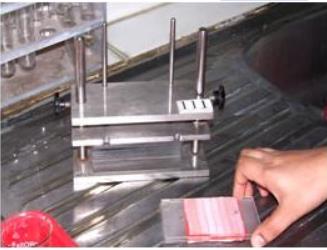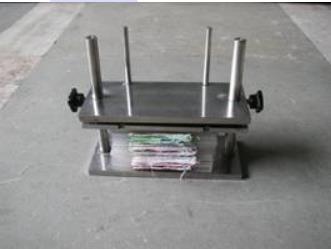
NewsInformation Center
The Perspiration Color Fastness Test
2018/01/31
There are cases where more color fading and alteration is caused by depending on the conditions under which garments are worn.Coupled with the eventual accumulation and concentration of perspiration, the reaction with sunlight is regarded as the cause for such occurrences, casting an influence on certain elements in the dye structure. To forecast such occurrences,methods for examining the components of perspiration under different conditions (acid and alkaline pH values) have been suggested by these standards.




Reagents:
•Alkaline Solution - Freshly prepared, composition as given in Table above
•Acid Solution - Freshly prepared, composition as given in Table above
Test Specimens
•Cut two specimens 100mm x 40mm (one specimen of 60 x60 cm in AATCC method) along the length or width direction. For multi-coloured fabrics, prints or stripes, all colours of the design should be in contact with all components of the multifibre.
•Where it is not possible for all colours to be in contact with all components, more than one test specimen may need to be prepared.
•For fabrics of different shade or fibre composition on face and back, both sides should be tested.
•Avoid samples within 50 mm of the selvedge.
•Cut two pieces of multifibre 40mm wide. The multifibre has selvedges and is approximately 100mm long. For AATCC method 60 x 60 cm size multifibre fabric is cut.Colourfastness Testing Series Colour fastness to Perspiration
•Align the test specimens and multifibre and sew together along one short edge to form a composite specimen.
Test Procedure
•Weigh each specimen. Calculate the amount of test solution according to a liquor ratio of 50:1, i.e. 50 ml test solution per 1g of specimen.
•Immerse one composite specimen in the alkaline solution and the other in the Acid solution for 30 minutes at room temperature to ensure that the specimens arethoroughly wetted out. (In AATCC method, place the test specimen in a 9 cm diameter and 2 cm deep Petri dish. Add only acid perspiration solution to a depth of 1.5 cm and soak for 30 min.)
•Place each specimen onto a resin plate and draw across with the stirring rod to remove any air bubbles. Place another resin plate on top of the specimen to fully enclose it. Place a maximum of ten specimens into the perspirometer ensuring that each specimen is separated by one resin plate. Use a separate perspirometer for each solution.
•(In AATCC method, pass the specimen through the wringer so that it weighs 2.25 ± 0.05 times the original weigh. To obtain consistent results all specimens of a given construction in a test series should have identical pickup, as the degree of staining increases with the amount of retained solution. Assemble the plates in the perspirometer with the specimens evenly distributed between the plates. Place all plates into the unit regardless of the number of specimens)
•Bring the upper pressure plate of the perspirometer down to rest on top of the resin plates and place the weight onto the pressure plate and tighten the securing screws.This is equal to a pressure of 12.5 KPa (5 kg) in between being applied on the specimens.
•Drain off any excess solution.
•Place the specimens into the oven at 37 ± 2°C, for hours (38 ± 1ºC, for 6 hours in AATCC method), set a timer for this.
•On completion of the test remove the specimens from the oven and separate them from the resin plates.
•Open out the specimens, so that they are only in contact at the line of stitching.
•Dry the specimens in an incubator or by laying on a screen at a temperature not exceeding 60°
Evaluation of results
•After drying, assess the specimens in a colour matching cabinet under D65, artificial daylight.
•Assess colour staining of all components on the multifibre using the grey scale for assessing staining.
•For multi-coloured prints only assess the worst area of staining on each component.
•Assess the change of shade on the original specimen compared to the tested specimen, using the grey scales for assessing change.
Previous: Necessities For Scrub Resistance Test
N e x t : Test Method for Abrasion Resistance of Textile



